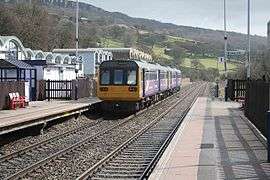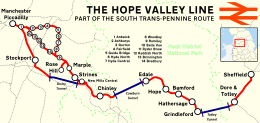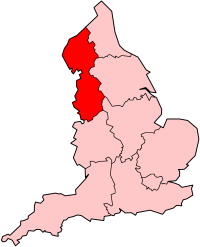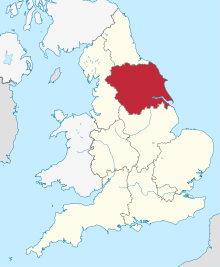Hope Valley line
The Hope Valley line is a trans-Pennine railway line in England, linking Sheffield with Manchester. It was completed in 1894.
| Hope Valley line | |||
|---|---|---|---|
 A pair of Northern Rail Pacers at Hathersage | |||
| Overview | |||
| Type | Heavy rail | ||
| System | National Rail | ||
| Status | Operational | ||
| Locale | North West England East Midlands | ||
| Termini | Manchester Piccadilly Sheffield | ||
| Operation | |||
| Opened | 6 November 1893 (goods) 1 June 1894 (passengers) | ||
| Owner | Network Rail | ||
| Operator(s) | East Midlands Railway Northern Trains TransPennine Express | ||
| Depot(s) | Longsight | ||
| Technical | |||
| Number of tracks | Two | ||
| Track gauge | 4 ft 8 1⁄2 in (1,435 mm) standard gauge | ||
| Electrification | 25 kV 50 Hz AC OHLE (Western part) | ||
| Operating speed | 90 mph (140 km/h) | ||
| |||
| Hope Valley Line | ||||||||||||||||||||||||||||||||||||||||||||||||||||||||||||||||||||||||||||||||||||||||||||||||||||||||||||||||||||||||||||||||||||||||||||||||||||||||||||||||||||||||||||||||||||||||||||||||||||||||||||||||||||||||||||||||||||||||||||||||||||||||||||||||||||||||||||||||||||||||||||||||||||||||||||||||||||||||||||||||||||||||||||||||||||||||||||||||||||||||||||||||||||||||||||||||||||||
|---|---|---|---|---|---|---|---|---|---|---|---|---|---|---|---|---|---|---|---|---|---|---|---|---|---|---|---|---|---|---|---|---|---|---|---|---|---|---|---|---|---|---|---|---|---|---|---|---|---|---|---|---|---|---|---|---|---|---|---|---|---|---|---|---|---|---|---|---|---|---|---|---|---|---|---|---|---|---|---|---|---|---|---|---|---|---|---|---|---|---|---|---|---|---|---|---|---|---|---|---|---|---|---|---|---|---|---|---|---|---|---|---|---|---|---|---|---|---|---|---|---|---|---|---|---|---|---|---|---|---|---|---|---|---|---|---|---|---|---|---|---|---|---|---|---|---|---|---|---|---|---|---|---|---|---|---|---|---|---|---|---|---|---|---|---|---|---|---|---|---|---|---|---|---|---|---|---|---|---|---|---|---|---|---|---|---|---|---|---|---|---|---|---|---|---|---|---|---|---|---|---|---|---|---|---|---|---|---|---|---|---|---|---|---|---|---|---|---|---|---|---|---|---|---|---|---|---|---|---|---|---|---|---|---|---|---|---|---|---|---|---|---|---|---|---|---|---|---|---|---|---|---|---|---|---|---|---|---|---|---|---|---|---|---|---|---|---|---|---|---|---|---|---|---|---|---|---|---|---|---|---|---|---|---|---|---|---|---|---|---|---|---|---|---|---|---|---|---|---|---|---|---|---|---|---|---|---|---|---|---|---|---|---|---|---|---|---|---|---|---|---|---|---|---|---|---|---|---|---|---|---|---|---|---|---|---|---|---|---|---|---|---|---|---|---|---|---|---|---|---|---|---|---|---|---|---|---|---|---|---|---|---|---|---|---|---|---|---|---|---|---|---|---|---|---|---|---|---|---|---|---|---|---|---|---|---|---|---|---|---|
| ||||||||||||||||||||||||||||||||||||||||||||||||||||||||||||||||||||||||||||||||||||||||||||||||||||||||||||||||||||||||||||||||||||||||||||||||||||||||||||||||||||||||||||||||||||||||||||||||||||||||||||||||||||||||||||||||||||||||||||||||||||||||||||||||||||||||||||||||||||||||||||||||||||||||||||||||||||||||||||||||||||||||||||||||||||||||||||||||||||||||||||||||||||||||||||||||||||||
From Sheffield, trains head up the Midland Main Line through the south west of the city to Dore and Totley, where the Hope Valley line branches off to run through the Totley Tunnel, the fourth-longest tunnel in England.
It emerges in the Hope Valley area of Derbyshire, where it passes through the railway stations of Grindleford, Hathersage, Bamford, Hope, and Edale before entering the two-mile-long Cowburn Tunnel.
From the western portal of the tunnel, the line runs through Chinley, then splits. The northern branch runs via New Mills Central toward Manchester Piccadilly. The southern branch passes through the Disley Tunnel before merging with the Buxton line and then heading to Stockport to join the main line to Manchester.
Passenger services on the line are operated by Northern Trains, East Midlands Railway and TransPennine Express.
History
Sheffield and Midland Joint Section
This section was built by the Sheffield and Midland Railway Companies' Committee as part of the Midland Railway's drive to reach Manchester with its line from London via Ambergate and Millers Dale. Initially, in 1867, it joined the Manchester, Sheffield and Lincolnshire Railway at Hyde Junction, running into Manchester London Road, but in 1875 a more direct route was built through Bredbury. When Manchester Central was opened by the Cheshire Lines Committee, a new line was built through Heaton Mersey. This third route was closed along with Manchester Central, apart from the section through Disley Tunnel to Hazel Grove, where it now joins the old LNWR line into Stockport.
Dore and Chinley
In 1872, the Midland Railway's only route from Sheffield to Manchester was via Ambergate. It had originally proposed a line to run from Dore to Hassop, meeting its extension from Rowsley to Buxton. However, the "Dore and Chinley Railway" was floated independently in 1872 and, unsuccessfully, until the Midland took an interest, since it would provide a more direct route, connecting through Chinley into Manchester.[1] The line was authorised in 1884 and work began in 1888.[2]
The 21-mile (34 km) line took five years to build, opening to goods traffic in November 1893, with passenger traffic being carried from June 1894.[3] The terrain through Hope Valley and Edale was easy enough by Midland standards, but at each end there were formidable obstacles, negotiated by means of the Totley and Cowburn Tunnels.
Recent history
At the time of the Beeching review, the line was running in competition with the recently modernised, faster route through the Woodhead Tunnel and its closure was suggested. On appeal, British Rail was required to keep the Hope Valley line open to passenger traffic; it was decided that the Woodhead route would be closed to passenger traffic instead,[4] (and then subsequently to all traffic in 1981) due to the high cost of further upgrading the line to modern standards.
Metrolink proposals
In the early 1980s, proposals were put forward to convert the Piccadilly–Belle Vue–Rose Hill/Marple section of the Hope Valley line to light rail operation for the proposed Manchester Metrolink system. While construction of Metrolink went ahead, the Hope Valley line was not included in the system which was completed in 1992.[5] When in 2000, proposals for a large-scale extension of Metrolink were announced by the government, these still did not include conversion of the Hope Valley line; but, subsequently, planning documents from Network Rail and from the Greater Manchester Passenger Transport Authority have suggested that this route might be appropriate for tram-train operation, and, as such, it was suggested to the Department for Transport as a possible location for a national tram-train pilot.
2019 closure
On 1 August 2019, the line was closed between Marple and Sheffield amid fears that the Dam at Toddbrook Reservoir would collapse, following heavy rain, which would flood the village of Whaley Bridge. The Buxton line, between Hazel Grove and Buxton, was also closed because of this. The line was re-opened on 7 August 2019.[6]
Plans
Nottinghamshire County Council and the Department for Transport have investigated the possibility of adding another service that does not call at Sheffield in order to improve the journey time between Nottingham and Manchester. Stopping (and changing direction) in Sheffield, the fastest journey is 110 minutes (in 2019), but the council has estimated bypassing Sheffield would cut the time to 85 minutes. Improvements to allow faster speeds on a 2 1⁄2-mile (4 km) stretch near Stockport could also shave off 2–3 minutes.[7][8]
Network Rail, in partnership with South Yorkshire ITA, will redouble the track between Dore Station Junction and Dore West Junction, at an estimated cost of £15 million. This costing is based on four additional vehicles in traffic to deliver the option, however, this will depend on vehicle allocation through the DfT rolling stock plan. This work will be programmed, subject to funding, in conjunction with signalling renewals in the Dore/Totley Tunnel area.
Other proposals include a 3,600 feet (1,100 m) loop in the Bamford area, in order to fit in an all-day (07:00–19:00) hourly Manchester–Sheffield via New Mills Central stopping service, by extending an existing Manchester–New Mills Central service.[9] Planning permission for this was granted in February 2018, but delays mean that this will now not be completed until 2023.[10]
These changes to allow three fast trains, a stopping train and freight trains each hour were also supported in a Transport for the North investment report in 2019, together with “further interventions” for the Northern Powerhouse Rail programme.[11]
Freight
Over a million tons of cement a year is taken away by rail from Earle's Sidings at Hope.[12]
References
| Wikimedia Commons has media related to Hope Valley Line. |
- Joy 1984, p. 171.
- Joy 1984, p. 267.
- Body, Geoffrey (1986). Railways of the Eastern Region. Vol. 1, Southern operating area. London: Guild Publishing. p. 142. ISBN 0850597129.
- Blackledge, Richard (22 April 2020). "Take an 'armchair journey' through the Peak District by rail with book's fascinating pictures - Beauty and strategic importance – these are the watchwords of the Hope Valley railway line between Sheffield and Manchester". infoweb.newsbank.com. Retrieved 4 July 2020.
- Greater Manchester Passenger Transport Executive (1984), Light Rapid Transit in Greater Manchester, GMPTE – publicity brochure
- "National Rail Enquiries - Service Alteration Details". www.nationalrail.co.uk. Retrieved 2 August 2019.
- "125mph trains to cut journey times". infoweb.newsbank.com. 12 April 2008. Retrieved 4 July 2020.
- "Nottinghamshire Local Transport Plan 2011-2026" (PDF). Nottinghamshire County Council. p. 78. Retrieved 25 July 2019.
- "Yorkshire & Humber RUS Appendix 4 - Options Appraisal" (PDF). Network Rail.
- Jeeves, Paul (3 October 2019). "Fury as vital rail link is delayed by 4 more years". infoweb.newsbank.com. Retrieved 4 July 2020.
- "Strategic Transport Plan" (PDF). Transport for the North.
- "Hope Cement Works Railway". sinfin.net. Retrieved 3 April 2016.
Sources
- Joy, David (1984). A Regional History of the Railways of Great Britain, Volume 8: South and West Yorkshire (2 ed.). Newton Abbot: David & Charles. ISBN 0-946537-11-9.CS1 maint: ref=harv (link)


